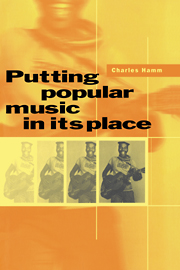Book contents
- Frontmatter
- Contents
- Acknowledgements
- Preface
- 1 Modernist narratives and popular music
- 2 Rock and the facts of life
- 3 Changing patterns in society and music: the US since World War II
- 4 “If I Were a Voice”: or, The Hutchinson Family and popular song as political and social protest
- 5 Some thoughts on the measurement of popularity in music
- 6 Elvis, a review
- 7 Home cooking and American soul in black South African popular music
- 8 Rock ‘n’ roll in a very strange society
- 9 African-American music, South Africa, and apartheid
- 10 “The constant companion of man”: Separate Development, Radio Bantu, and music
- 11 Privileging the moment of reception: music and radio in South Africa
- 12 Music and radio in the People's Republic of China
- 13 Towards a new reading of Gershwin
- 14 A blues for the ages
- 15 Graceland revisited
- 16 Dvořák in America: nationalism, racism, and national race
- 17 The last minstrel show?
- 18 The Role of Rock, a review
- 19 Genre, performance, and ideology in the early songs of Irving Berlin
- 20 Epilogue: John Cage revisited
- Index
4 - “If I Were a Voice”: or, The Hutchinson Family and popular song as political and social protest
Published online by Cambridge University Press: 05 February 2012
- Frontmatter
- Contents
- Acknowledgements
- Preface
- 1 Modernist narratives and popular music
- 2 Rock and the facts of life
- 3 Changing patterns in society and music: the US since World War II
- 4 “If I Were a Voice”: or, The Hutchinson Family and popular song as political and social protest
- 5 Some thoughts on the measurement of popularity in music
- 6 Elvis, a review
- 7 Home cooking and American soul in black South African popular music
- 8 Rock ‘n’ roll in a very strange society
- 9 African-American music, South Africa, and apartheid
- 10 “The constant companion of man”: Separate Development, Radio Bantu, and music
- 11 Privileging the moment of reception: music and radio in South Africa
- 12 Music and radio in the People's Republic of China
- 13 Towards a new reading of Gershwin
- 14 A blues for the ages
- 15 Graceland revisited
- 16 Dvořák in America: nationalism, racism, and national race
- 17 The last minstrel show?
- 18 The Role of Rock, a review
- 19 Genre, performance, and ideology in the early songs of Irving Berlin
- 20 Epilogue: John Cage revisited
- Index
Summary
My book Yesterdays was not written as an overview of popular music but as a narrative history of the musical and social origins of a single genre, popular song, which I defined as follows:
written for, and most often performed by, a single voice or a small group of singers, accompanied by either a single chord-playing instrument or some type of band, ensemble, or small orchestra;
usually first performed and popularized in some form of secular stage entertainment, and afterwards consumed (performed or listened to) in the home;
composed and marketed with the goal of financial gain;
Designed to be performed by and listened to by persons of limited musical training and ability; and
produced and disseminated in physical form – as sheet music in its early history, and in various forms of mechanical reproduction in the twentieth century.
There was no intent of privileging this genre over others. As I pointed out myself, this definition “excludes the music of William Billings, which is for vocal ensemble; Child ballads and other traditional Anglo-American songs, which were transmitted in oral tradition; the band music of John Philip Sousa and the ragtime music of Scott Joplin and others, which is instrumental; all church music, even that for solo voice; most jazz, which is instrumental.” But I emphasized that “the exclusion of these and other kinds of music from this book – except as they exert direct influence on popular song – does not imply that they are less interesting or important than the music dealt with here, merely that they are something different.”
- Type
- Chapter
- Information
- Putting Popular Music in its Place , pp. 98 - 115Publisher: Cambridge University PressPrint publication year: 1995



